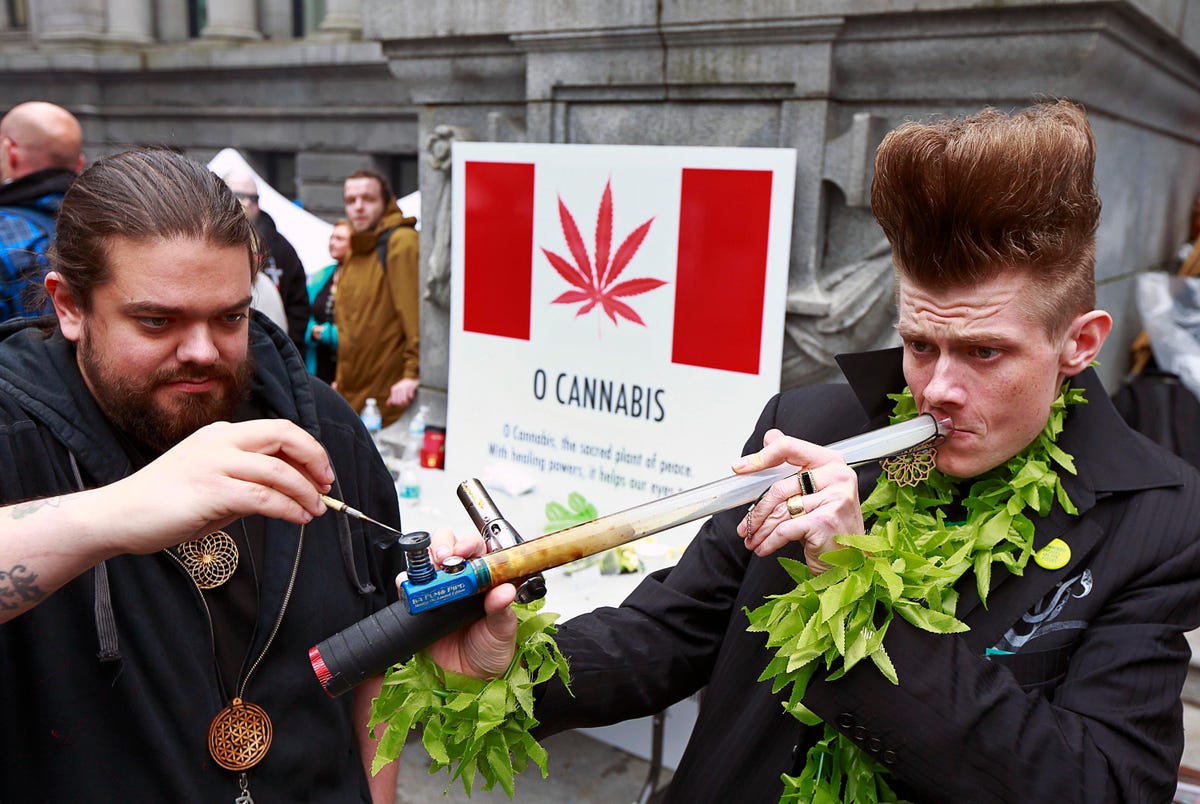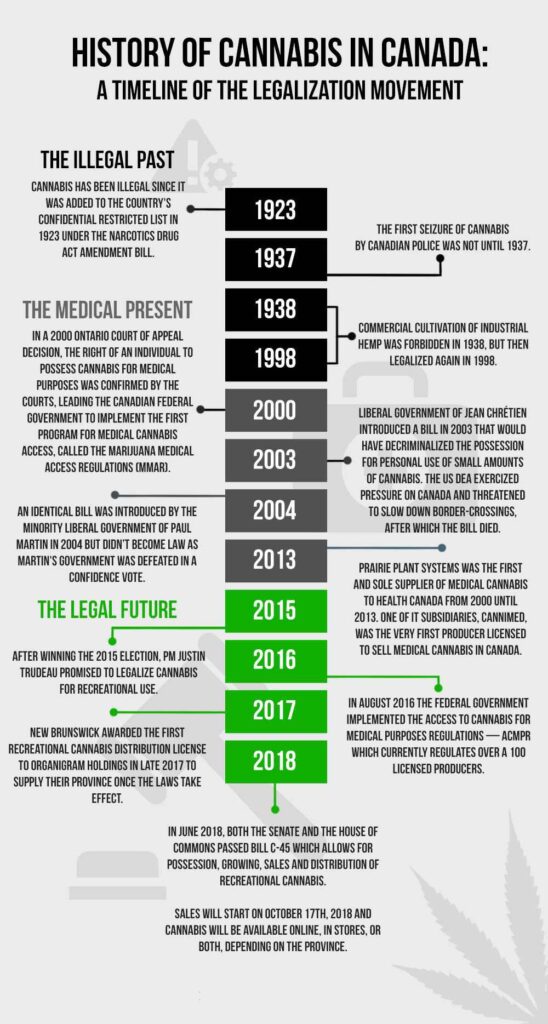- A brief overview of the History of Cannabis in Canada
II. Early History of Cannabis in Canada
- Use of Cannabis by Indigenous Peoples in Canada
- Cannabis introduced to Canada by European settlers
- Early cannabis laws in Canada
III. Prohibition Era
- Rise of anti-cannabis sentiment in Canada in the early 20th century
- Establishment of the Opium and Narcotic Drug Act in 1923, which criminalized cannabis use and possession
- Enforcement of cannabis prohibition in Canada
- The emergence of medical cannabis as a treatment option in the 1990s
- Establishment of the Marijuana Medical Access Regulations in 2001, which allowed for legal medical cannabis use in Canada
- Changing attitudes towards cannabis in Canada
- Introduction of the Cannabis Act in 2018, which legalized recreational cannabis use in Canada
- Impact of Legalization on the cannabis industry in Canada
VI. Conclusion
- Recap of the history of cannabis in Canada
- Discussion of the Future of Cannabis in Canada
I. A brief overview of the History of Cannabis in Canada
Cannabis has a long and complex history in Canada. Indigenous peoples in Canada have been using cannabis for medicinal, spiritual, and recreational purposes for centuries. The plant was introduced to Canada by European settlers in the 17th century, and its use continued to grow over the following centuries.
In the early 20th century, however, attitudes toward cannabis began to shift. The Canadian government began to view cannabis as a dangerous drug, and in 1923, it was added to the list of prohibited substances under the Opium and Narcotic Drug Act. This act made it illegal to possess, use, or sell cannabis in Canada, and the government began enforcing strict penalties for those caught violating the law.
Despite this prohibition, cannabis continued to be used in Canada, particularly among certain subcultures such as jazz musicians and artists. In the 1960s and 70s, cannabis use became more mainstream, as part of the broader countercultural movement of the time.
In the 1990s, the medical cannabis movement emerged in Canada. Patients suffering from chronic pain, cancer, and other conditions began to advocate for the use of cannabis as a treatment option, and some doctors began prescribing it for medical purposes. This led to the establishment of the Marihuana Medical Access Regulations in 2001, which allowed for legal medical cannabis use in Canada.
In 2018, Canada took the historic step of legalizing recreational cannabis use, becoming only the second country in the world to do so (after Uruguay). The Cannabis Act, which went into effect on October 17, 2018, allows adults in Canada to possess and use cannabis for recreational purposes, subject to certain regulations.
Today, cannabis is a thriving industry in Canada, with a wide range of products and services available to consumers. From cannabis seeds to edibles to medical cannabis, Canadians have more options than ever before when it comes to using this plant. While the history of cannabis in Canada has been a complex and sometimes fraught one, the future of this industry looks bright.
II. Early History of Cannabis in Canada
Use of Cannabis by Indigenous Peoples in Canada
Cannabis has been an important part of Indigenous cultures in Canada for centuries. Indigenous peoples have used the plant for medicinal, spiritual, and recreational purposes, and it has played a significant role in their traditional practices and ceremonies.
Archaeological evidence suggests that cannabis was used by Indigenous peoples in North America as far back as 2,500 years ago. The plant was used for a wide range of purposes, including pain relief, stress reduction, and spiritual enlightenment. Indigenous peoples also used cannabis in various traditional practices, such as sweat lodges, vision quests, and healing ceremonies.
In addition to its spiritual and medicinal uses, cannabis also played a role in Indigenous trade networks. The plant was used as a form of currency in some Indigenous cultures, and it was traded along with other valuable goods such as furs, tobacco, and wampum.
Despite the long history of cannabis use among Indigenous peoples in Canada, the arrival of European settlers in the 17th century brought significant changes to their relationship with the plant. European settlers viewed cannabis as a dangerous drug and sought to prohibit its use, which led to the criminalization of cannabis in Canada in the early 20th century.
Today, many Indigenous peoples in Canada continue to use cannabis for medicinal, spiritual, and recreational purposes. However, they have also been disproportionately affected by cannabis prohibition, and many have been unfairly targeted and criminalized for their use of the plant. In recent years, there has been a growing movement among Indigenous communities in Canada to reclaim their traditional relationship with cannabis and to advocate for greater control over the cannabis industry.
Cannabis introduced to Canada by European settlers
European settlers first introduced cannabis to Canada in the 17th century. The plant was brought to the country by French colonizers, who used it primarily for its fiber content to make rope, sails, and other textiles. Cannabis was also grown by British settlers in the 18th century for similar purposes.
As European settlement in Canada grew, so did the use of cannabis. By the mid-19th century, cannabis had become a popular recreational drug among certain groups, such as soldiers, loggers, and sailors. The plant was also used in various patent medicines and tonics, which claimed to cure a wide range of ailments from headaches to insomnia to cholera.
By the early 20th century, however, attitudes toward cannabis began to shift. The Canadian government began to view cannabis as a dangerous drug, and in 1923, it was added to the list of prohibited substances under the Opium and Narcotic Drug Act. This act made it illegal to possess, use, or sell cannabis in Canada, and the government began enforcing strict penalties for those caught violating the law.
Despite this prohibition, cannabis use continued in Canada, particularly among certain subcultures such as jazz musicians and artists. In the 1960s and 70s, cannabis use became more mainstream, as part of the broader countercultural movement of the time.
Today, cannabis is a significant part of Canadian culture, with the country being one of the largest producers and exporters of cannabis in the world. While the history of cannabis in Canada has been a complex and sometimes fraught one, it continues to play an important role in the country’s cultural and economic landscape.
Early cannabis laws in Canada
Early cannabis laws in Canada were primarily focused on controlling the use of the drug by certain groups, such as immigrants and Indigenous peoples. In the early 20th century, the Canadian government enacted a series of laws aimed at restricting the use of cannabis and other drugs, which were viewed as a threat to public health and safety.
The Opium and Narcotic Drug Act of 1923 was the first federal law to prohibit the possession, use, or sale of cannabis in Canada. The law was primarily aimed at controlling the use of opium and other narcotics, but cannabis was included as well. Those found guilty of violating the law faced fines, imprisonment, and even deportation for immigrants.
In the years following the introduction of the Opium and Narcotic Drug Act, several other laws were passed aimed at further restricting the use of cannabis. In 1937, the Department of Health and Welfare issued an order prohibiting the sale of cannabis for any purpose, including medical use.
These early cannabis laws were often enforced in a discriminatory manner, with Indigenous peoples and immigrants being disproportionately targeted and penalized for their use of the drug. The harsh penalties for cannabis possession and use remained in place throughout much of the 20th century, with little public debate or discussion of their effectiveness.
It wasn’t until the 1960s and 70s that public attitudes toward cannabis began to shift, as part of the broader countercultural movement of the time. Calls for the legalization or decriminalization of cannabis began to gain traction in the 1990s and 2000s, leading to the eventual legalization of cannabis for recreational use in Canada in 2018.
III. Prohibition Era
Rise of anti-cannabis sentiment in Canada in the early 20th century
Anti-cannabis sentiment began to rise in Canada during the early 20th century, as part of a broader global trend of moral panic around drug use. At the time, cannabis was associated with immigrants and marginalized groups and was often portrayed in the media as a dangerous and addictive drug that posed a threat to public health and safety.
Establishment of the Opium and Narcotic Drug Act in 1923, which criminalized cannabis use and possession
In response to these concerns, the Canadian government passed the Opium and Narcotic Drug Act in 1923, which criminalized the use, possession, and sale of cannabis in the country. The act was primarily aimed at controlling the use of opium and other narcotics, but cannabis was included as well.
Under the act, those found guilty of possessing or using cannabis could face fines, imprisonment, and even deportation for immigrants. The act also established a system of licensing for the medical use of narcotics, which effectively limited the medical use of cannabis to a small number of licensed individuals.
Enforcement of cannabis prohibition in Canada
Enforcement of cannabis prohibition in Canada was initially sporadic, with many police officers and government officials unsure of how to interpret and enforce the new law. However, as anti-cannabis sentiment continued to grow in the country, enforcement of the law became more strict and punitive.
Throughout the 20th century, police conducted numerous raids on cannabis grow operations and seized large quantities of the drug. Indigenous peoples and other marginalized groups were often targeted for their use of the drug and faced disproportionately harsh penalties for possession and use.
Despite these efforts, however, cannabis use persisted in Canada throughout the prohibition era, particularly in urban areas and among young people. Calls for the legalization or decriminalization of cannabis began to gain traction in the latter half of the 20th century, leading to the eventual legalization of cannabis for recreational use in 2018.
IV. Medical Cannabis Movement
The emergence of medical cannabis as a treatment option in the 1990s
The use of cannabis for medical purposes began to gain attention and acceptance in Canada during the 1990s. In 1999, the Canadian government introduced regulations allowing patients with certain medical conditions to access cannabis for medical purposes.
Initially, access to medical cannabis was limited to a small number of licensed producers, and patients had to obtain a medical prescription to access the drug. However, in 2013, the government introduced new regulations allowing licensed individuals to grow their own cannabis for medical purposes and allowing licensed producers to sell cannabis products to authorized patients.
Today, medical cannabis is used to treat a wide range of conditions, including chronic pain, multiple sclerosis, epilepsy, and cancer-related symptoms. The use of medical cannabis is subject to strict regulations and oversight by Health Canada, to ensure that patients receive safe and effective treatment.
Establishment of the Marijuana Medical Access Regulations in 2001, which allowed for legal medical cannabis use in Canada
In 2001, the Canadian government introduced the Marijuana Medical Access Regulations (MMAR), which established a legal framework for the medical use of cannabis in the country. Under the MMAR, patients with certain medical conditions could access cannabis for medical purposes, with a medical prescription from a licensed healthcare practitioner.
The MMAR also established a system of licensed producers, who were authorized to produce and distribute medical cannabis products to authorized patients. Initially, the program was limited to a small number of patients and producers, but it expanded over time to accommodate a growing number of medical cannabis users.
The MMAR remained in effect until 2013, when it was replaced by the Marihuana for Medical Purposes Regulations (MMPR). The MMPR introduced a number of changes to the medical cannabis program, including a shift to a more commercial model of production and distribution, and the establishment of a system of licensed commercial producers. The MMPR was subsequently replaced by the Access to Cannabis for Medical Purposes Regulations (ACMPR) in 2016, which made further changes to the program and expanded access to medical cannabis for authorized patients.
V. Road to Legalization
Changing attitudes towards cannabis in Canada
In the years leading up to legalization, attitudes towards cannabis began to shift in Canada. Public opinion polls consistently showed a growing acceptance of cannabis use, particularly for medical purposes. A number of high-profile cases involving individuals using cannabis for medical purposes helped to raise awareness of the potential benefits of the drug, and the shortcomings of the existing legal framework for medical use.
At the same time, concerns were raised about the social and economic costs of cannabis prohibition. Critics argued that prohibition had failed to effectively address the harms associated with cannabis use, and had resulted in unnecessary criminalization and harm to vulnerable populations.
Introduction of the Cannabis Act in 2018, which legalized recreational cannabis use in Canada
In 2018, the Canadian government introduced the Cannabis Act, which legalized recreational cannabis use in the country. The Act created a legal framework for the production, distribution, sale, and possession of cannabis, with strict regulations and oversight by Health Canada.
Under the Cannabis Act, adults aged 18 or older are allowed to possess up to 30 grams of cannabis in public and to grow up to four cannabis plants per household for personal use. The Act also established a system of licensed producers, who are authorized to produce and distribute cannabis products to authorized retailers.
While legalization has been a significant step forward for cannabis policy in Canada, it has also presented a number of challenges for policymakers, regulators, and industry stakeholders. Issues related to product quality and safety, supply and demand, and the black market have all emerged as important considerations for the cannabis industry and its regulators.
Impact of Legalization on the cannabis industry in Canada
Legalization has had a profound impact on the cannabis industry in Canada. Since legalization, the industry has experienced significant growth, with new businesses and investors entering the market, and existing companies expanding their operations.
However, the industry has also faced a number of challenges. The initial rollout of legalization was marred by supply shortages, delays in licensing, and other issues that hindered the development of the legal market. Meanwhile, the black market for cannabis continues to pose a significant challenge for industry stakeholders and regulators, who are working to address issues related to illegal sales, product safety, and consumer protection.
Despite these challenges, the cannabis industry in Canada continues to grow and evolve, with new products, technologies, and innovations emerging to meet the needs of consumers and patients alike. As the industry continues to mature, it is likely to play an increasingly important role in the Canadian economy and society.
Conclusion
Recap of the history of cannabis in Canada
The history of cannabis in Canada is a complex and multifaceted story, spanning centuries of use by Indigenous peoples, the arrival of European settlers, and decades of prohibition and criminalization. In recent years, changing attitudes towards cannabis has led to the legalization of medical and recreational use in Canada, and the emergence of a rapidly growing industry.
Despite the progress made toward legalization, the cannabis industry in Canada continues to face a number of challenges, from product safety and quality concerns to regulatory hurdles and the persistence of the black market. Nonetheless, the industry has already had a significant impact on the Canadian economy and society and is likely to play an increasingly important role in the years to come.
Discussion of the Future of Cannabis in Canada
Looking ahead, the future of cannabis in Canada is likely to be shaped by a range of factors, from changing consumer preferences and market trends to technological innovations and regulatory developments. As the industry continues to mature, it will be important for policymakers, regulators, and industry stakeholders to work together to address emerging challenges and opportunities, and to ensure that the benefits of cannabis legalization are realized by all Canadians.
One area of particular interest is the potential for cannabis to be used as a treatment for a range of medical conditions, from chronic pain and epilepsy to anxiety and depression. While research in this area is still in its early stages, there is growing evidence to suggest that cannabis may have significant therapeutic benefits, and could become an important tool for healthcare professionals in the years to come.
Ultimately, the future of cannabis in Canada will be shaped by a range of factors, from the ongoing evolution of consumer preferences and market dynamics to the changing landscape of healthcare policy and regulation. As the industry continues to grow and evolve, it will be important for all stakeholders to work together to ensure that the benefits of cannabis legalization are realized in a safe, responsible, and sustainable manner.






